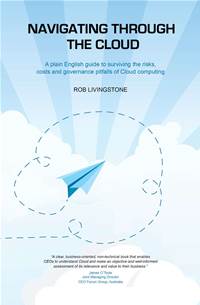The democratisation or consumerisation of IT


Some IT industry commentators and analysts have been drawing analogies between cloud computing and technologies such as electric power for a number of years.
Nicholas Carr predicted the consumerisation of IT and the emergence of utility style computing services as early as 2004.
In the example of the electricity industry, as costs reduced through electricity generation and transmission technology advances, combined with a common standard for interoperability, opportunities opened up for forward-looking organisations to gain strong competitive advantages by using these new utility style services.
Once these services become universally accessible with no material barrier to switching suppliers, they become a true commodity.
1. The conventional ‘on‐premises’ IT system
Since the large mainframe computer era of the ‘70s and before the advent of the internet and subsequently cloud computing, organisations generally had no alternative other than to struggle with the cost and complexities of on-premises IT systems.
- The most obvious are the complex enterprise software projects that used ‘off the shelf’ IT systems (e.g. Oracle, SAP and other ERP Systems). Not only do the upfront license costs require capital investment, organisations invariably have to upgrade data centre hardware and IT infrastructure on which the new or upgraded systems run.
Each installation of these enterprise systems is invariably lengthy, time consuming and expensive processes. At the end of the project, organisations hope that the investment results in a system that meets their business needs.

- In some ‘on-premises’ projects, during the lengthy time taken to design, configure and implement these systems, the business needs have changed, forcing further project delays as the software needs to be modified to meet these new requirements. This, in turn, adds to the cost and complexity of enterprise IT projects of this nature.
2. Cloud: Implement now, modify later
One of the value propositions of Cloud is the ability to implement a fully functioning system at the start, with minimal IT effort, and then potentially configure it later if needed.

3. Cloud computing: Making changes by configuration, not programming
An important concept to grasp at the core of Cloud computing is the mechanism by which system changes are implemented to meet your business’ requirements.
Generally speaking, changes to the operation of software systems are made by either programming or configuration, or a combination of both.
- Programming changes require specialised technical expertise in the underlying software program’s languages and logic, whereas
- Configuration can be done without any specific technical expertise.
Configuration changes affect how the system operates and appears to users, and is usually implemented by system administrators that access configuration maintenance screens. No change to the underlying software program is made. This important concept has implications for how a cloud system is managed and modified within your organisation, in that configuration generally provides limits to how far one can change the system’s behaviour. To implement complex and detailed changes usually requires changes to the underlying programs, by making programming changes to the software itself.
4. Public Cloud: Good for individuals and organisations alike?
The cloud computing model scales continuously from the individual to large enterprises, as the basis of service delivery and payment is, typically, on a per user per month basis.
Simply put, the more you use, the more you pay. This model has distinct appeal and advantages for both individuals and organisations.
a) Public Cloud technologies – targeting individuals (i.e. the public)
A single individual can access software systems that previously were only available to larger corporations.
These technologies are openly accessible by the general public. Examples of these are Gmail (Google’s cloud-based mail and messaging system) and Facebook (the popular social networking site). These are common systems that are accessed, equally by all users. Whilst you can make some limited configuration changes to your instance of the system to meet your needs, the ‘back-end’ cannot be accessed or modified. You may, however, be able to utilise an ecosystem of third party ‘plug-ins’ that extend functionality of the base system.
Likewise, in the business world, a large number of cloud applications are available to organisations, including enterprise strength CRM (Customer Relationship Management) systems, content management systems, website portals, accounting and sales and marketing systems. These often have greatest appeal to startup / small organisations and sole traders alike, and are typically, ideal candidates for the Public Cloud.
b) Public Cloud technologies – targeting enterprises
Organisations are able to implement enterprise-ready systems in very short timeframes, with minimal effort.
A fully functioning enterprise cloud system can be configured and launched in days, with negligible start-up cost. This equates to the speed with which an individual would setup and configure their home PC!
In the eyes of many users and organisations, cloud indeed offers a very compelling proposition. Potentially, you do not even need the involvement of your IT department to launch a business system.
5. Cloud and the changing role of IT
These influences, when combined, make for a somewhat difficult position for the conventional IT Department, who mostly have to still maintain a large pool of on-premise enterprise IT systems, keep the business going, and meet all the existing performance and compliance requirements of the organisation.
A by-product of the uptake of cloud computing by organisations is the shift in the role of the conventional internally managed IT department.
- When users and non-IT executives within organisations feel frustrated at the apparent slow speed of delivery of IT projects, systems that appear to be unnecessarily complex, not to mention the perceived high cost of IT support, the availability of alternative Cloud based serviced and systems have obvious appeal.
- This is especially relevant, when the same users and non-IT executives have had their own, largely positive experiences in using cloud computing as an individual outside of their organisation.
The value of cloud is exemplified by:
- the ease of use and pervasiveness of technologies such as YouTube, Gmail, Facebook, LinkedIn, Amazon and commercially robust and mature cloud systems such as SalesForce and Google ; and
- the recent advent of the all-pervasive and powerful cloud-enabled iPhones, iPads, Android and other mobile computing technologies which deliver individual consumers low cost, high value applications that can be deployed in minutes.
Read on for some practical advice on dealing with these pressures...
6. Is cloud driving the transformation of the enterprise IT department?
The reality that IT systems can be low cost, easy to use, intuitive, and easy to implement in the personal lives of users translates directly to the perception and expectation that corporate or enterprise IT systems should be similarly easy to use, highly flexible, quick to implement and very low cost.
This perception is fuelled by two primary influences:
- Individuals can access and experience the cloud systems first hand, without needing IT involvement; and
- Individuals are neither subject to the complexities of coordinating enterprise wide IT systems nor subject to the often stringent governance requirements and related mandates.
For organisations, these governance requirements do not change in moving enterprise systems to Cloud Computing. Expecting IT departments to not meet minimum due diligence and governance standards because the system is ‘Cloud’, requires a clear and unequivocal mandate from the Directors of the organisation to this effect. Clearly, this does also not excuse enterprise IT departments that are poorly run from making poor decisions. Where IT departments are poorly run and badly aligned with the organisation’s business plans and objectives, these issues need to be remedied.
Cloud computing may be a solution for part of your organisation’s IT systems, but replacing your IT department with the Cloud is a strategy that needs extensive due diligence. Fix your organisation’s IT management issues first, then consider the cloud, not the opposite.
7. What are the implications for procurement?
Due to the speed and relative ease of access to cloud technologies, there is a risk of the unmanaged proliferation of cloud technologies within organisations.
- Where uncontrolled or unauthorised enterprise systems exist, so do the potential risks of information security problems, data integrity issues and compromises to the integrity of business processes.
There are a number of considerations in the selection and implementation of xloud systems in your organisation, as discussed below.
a) Cloud is a technology and delivery mechanism choice. Manage it as such
Cloud technology contains your organisation’s business logic and data, and as such it required some effort to maintain its:
- Accuracy;
- Integrity;
- Security;
- Availability; and
- Interface to any other of your IT systems.
b) Have clear accountabilities over your cloud implementation
Cloud systems are, in principle, no different from your existing on-premises IT systems. Someone (i.e. a specific Director) in your organisation should have ultimate accountability for the cost, risk, use and overall governance of your enterprise systems.
Should a line-of-business departmental manager wish to select, implement and manage their own local enterprise systems, they should be able to do so only under the full visibility and rigours of your enterprise IT governance framework.
c) The importance of a clearly articulated cloud procurement policy
Given that a SaaS Cloud system can be deployed in minutes and paid for out of the discretionary budget of a department within most organisations, it has the potential to expose the organisation to the risk of a ‘viral cloud’.
- A viral cloud is characterised by a localised initial installation of a cloud system (approved or otherwise!) in one part of the organisation, for a defined purpose. After a short period of time, access if progressively granted to others outside of the initial user pool as either the popularity of the system gains a foothold, or others need to be given access to approve workflows, access documents, process information etc.
The low entry cost threshold for cloud systems could mask the potential for significant future Total Cost of Ownership (TCO), unmitigated risk and breach of minimum governance standards.
- Due to the ease of provisioning, access, configuration and use, there is increased risk of local divisions or business units in an organisation independently implementing cloud technologies by using local, discretionary budgets, in the absence of an effective cloud policy framework.
Organisations need to have effective cloud computing policies to mitigate against the risks of ungoverned enterprise applications.
In the absence of a clearly articulated cloud computing policy, traditional capital investment purchase processes can by bypassed, as individual user subscription costs are mostly treated as routine expenditure within the local business unit.
This has implications in multinational and multi-divisional organisations, where a local business unit wishes to implement an IT system to meet a local requirement.
d) Cloud: Low barrier to entry leading to vendor lock-in
Enterprise cloud systems have a very low entry threshold. For a few hundred dollars a month, a small but potentially influential pool of users could deploy an important application, which, when scaled out across the enterprise, could be prohibitively expensive.
Cloud computing has the potential to unleash the pent-up demand for better systems, improved reliability, less complexity, greater mobility and choice. All of these requirements are frequently valid at a local level, however organisations still require appropriate governance and due diligence processes to ensure that local decisions do not adversely impact the organisation as a whole.
IT departments often are in a unique position as they have a perspective of the entire organisation, and are required to balance the demands of a particular division or business unit against the requirements of the organisation as a whole.
The takeaway messages from this chapter are:
- The immediacy and universal access to cloud technologies allows individuals and organisations alike, to implement systems ‘on-demand’. This has potential implications for the procurement and project management approaches in the selection and implementation of enterprise IT systems.
- Individual positive personal experiences in using cloud systems are driving the demand for a similar level of service delivery by organisation’s own IT departments.
- Understand how and why cloud has the potential to transform your view of the relevance and operation of your in-house IT department.
- A cautious and unduly ‘defensive’ posture taken by your IT department to a move to cloud computing needs assessment, and may be made on justifiable grounds. Investigate, don’t dismiss or mandate.
This is an extract from ‘Navigating through the Cloud’ by Rob Livingstone. Reprinted with permission. ‘Navigating through the Cloud’ features features a cloud assessment framework and other practical advice and is available for download online.


_(22).jpg&h=140&w=231&c=1&s=0)
_(20).jpg&h=140&w=231&c=1&s=0)
.png&h=140&w=231&c=1&s=0)




_(26).jpg&w=100&c=1&s=0)

 iTnews Executive Retreat - Security Leaders Edition
iTnews Executive Retreat - Security Leaders Edition












_(1).jpg&h=140&w=231&c=1&s=0)



